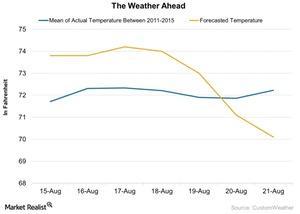How Will the Weather Impact Natural Gas This Week?
In the week ending August 12, temperatures were higher than the forecast for the week. Natural gas futures fell 6.7% for the week ending on August 12.
Aug. 15 2016, Published 8:29 a.m. ET

What’s the weather forecast?
The weather forecast for August 15–21, 2016, indicates that temperatures in the US could remain higher than the mean of the last five years for the same period, except on August 20 and August 21. Higher temperatures increase the use of natural gas (UNG) (DGAZ) (BOIL) (FCG) (UGAZ) (GASL) for cooling purposes during the summer. Mainly, electric utilities that use natural gas will have to boost supplies to satisfy the cooling demand.
El Niño anomalies
Natural gas usage for heating during the 2015–2016 winter season was low due to mild weather. El Niño’s intensity kept temperatures warmer than normal. As a result, at the end of March 2016, US natural gas inventories were at 2.5 trillion cubic feet—67% higher than their 2015 levels and 53% higher than their five-year average.
In the week ending August 12, 2016, temperatures were higher than the forecast for the week. However, natural gas futures fell 6.7% for the week ending on August 12, 2016, due to market expectations that the soon-to-end summer would fall short of undoing the bearish pressure from strong supplies.
On August 11, 2016, the EIA (U.S. Energy Information Administration) announced a 29 Bcf (billion cubic feet) addition in natural gas inventory levels for the week ending August 5, 2016. Analysts expected an addition of 21 Bcf to the inventory, according to a report by the Wall Street Journal. The larger-than-expected build in the inventory also pressured prices.
The above analysis could be important for natural gas–tracking commodity ETFs such as the ProShares Ultra Bloomberg Natural Gas (BOIL), the Direxion Daily Natural Gas Related Bear 3X ETF (GASX), and the Direxion Daily Natural Gas Related Bull 3X ETF (GASL).
In the next part of this series, we’ll take a look at the price performances of natural gas, crude oil, and the S&P 500 Index (SPY) (SPXL).
